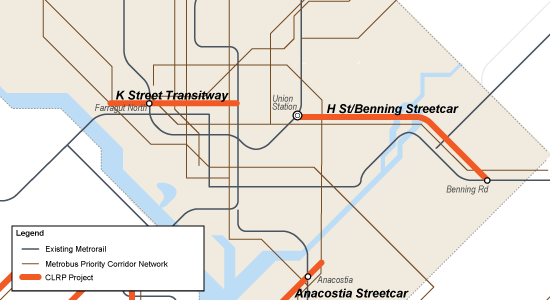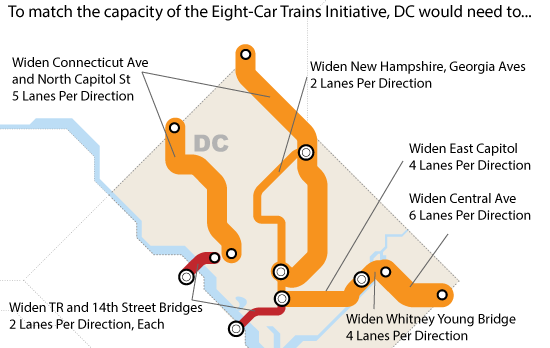What Metro 2025 Means for the District of Columbia
Metro 2025 would bring significant benefits to the District of Columbia, allowing the city to thrive economically while preserving neighborhoods and downtown vitality.
Metro’s Momentum plan calls for seven Metro 2025 initiatives – from eight-car trains to bus-only lanes, which will bring dramatic improvements to the quality of life and transportation in the District.
Supports D.C. Transit Projects
The District has committed to a 50% market share for public transportation, and is building a Streetcar and expanded Circulator network that will depend on robust Metrorail and Metrobus services. Metro concurs that the Streetcar and Circulator are worthwhile ventures, but they will always rely on the supporting regional “backbone” of Metrorail and Metrobus in order to deliver their intended results. Consider that every single planned D.C. Streetcar line in the 22-mile system begins, ends, or connects with a Metrorail station, and the importance of sufficient capacity on Metrorail becomes quite clear.
Today, more than 100,000 people a month transfer between Metro and the Circulator. By 2040, even the first few lines of the D.C. Streetcar (those funded in the CLRP, not even counting the full 22-mile system) are projected to generate thousands of additional transfers to Metrorail and Metrobus each day.

D.C. Streetcar projects funded in the CLRP. The planned 22-mile system would construct even more lines.
By ensuring that Metro services can keep pace with congestion and demand, Metro 2025 is critical to making D.C.’s transit projects a success, and critical to helping D.C. reach it’s transportation goals.
![]()
Supports D.C.’s Growing Population and Economy
The District of Columbia’s population is surging, and its economic and population growth is only projected to grow. With that growth comes significant transportation needs, and Metro 2025 is critical to Metro’s success in meeting that growth.
- Since 2000, the District’s population has boomed by over 13%, and in 2013 topped 640,000 residents for the first time since the 1970s.
- Leading this growth has been Gen Y, who increasingly take public transportation if they even have driver licenses.
- By 2040, D.C. is projected to see an influx of nearly 200,000 jobs, or an increase of 25%.
To handle this growth, D.C. needs the rail and bus system that Metro 2025 would deliver: 8-car trains capable of moving the equivalent of 16-18 lanes of highways into the District, superior bus service, and more. For example, Metrobus is helping the 16th Street NW corridor to grow – ridership has surged by over 5,000 trips per day, and today buses are 3% of the vehicles but move 50% of the people on that road.
Alternatively, if we were to support this growth with highway investments, we could need the equivalent of 216 lane-miles of pavement, including three bridges and 16 new arterial lanes in each direction through the District. This investment in D.C. alone could reach upwards of $1.7 billion. All those drivers would need somewhere to park, so 28,900 parking spaces would need to be constructed in the District, costing another $600 million.

To match the same capacity as Metro 2025, the District would have to add 16 lanes of roadways in each direction. Red are freeways and orange are arterials.
Relieves Crowding on Trains and Buses
Metrorail and Metrobus are full to capacity, and D.C. residents feel it every day.
- In many places, trains are already full by the time they reach stations in the District, and D.C. residents cannot find a seat or must wait for the next train.
- Today, over 11,000 D.C. residents each day experience uncomfortably crowded conditions on-board Metrorail, expected to increase to 15,000 D.C. residents by 2025.
- Nearly 16,000 D.C. residents each day pass through a crowded Metrorail station – often encountering lines for elevators, escalators, or fare gates.
- At the same time, over 11,200 D.C. residents every day ride a crowded bus.
- Without Metro 2025, crowding on Metrorail is projected to more than double (increase by 113%).
Running all 8-car trains at peak times cuts the number of riders experiencing crowding from 26% to 9%, especially at peak load points such as: Navy Yard, Mt. Vernon Square, Dupont Circle, Gallery Place, and Foggy Bottom.

Metro 2025 will relieve significant crowding for over 15,000 D.C. residents at peak load points on Metrorail during the peak hour in 2025.
Saves Time and Money for D.C. Riders and Drivers Alike
By simultaneously taking 135,000 cars off the road and improving transit, Metro 2025 saves time for both transit riders and drivers.
- Metro 2025 results in almost 80,000 fewer cars on D.C. roads every day, reducing traffic jams and air pollution within the District (only 11% of which would have been driven by District residents)
- D.C. residents, 40% of whom commute by transit today, would see buses that move faster and Metrorail riders will move faster through the system due to less station This will save District residents time worth $14 million per year.
- Riders and drivers alike would save another $10 million per year in out-of-pocket travel costs like gas and car maintenance.
![]()
Reduces Costs to the District
Metro 2025 will make Metro more efficient, allowing us to reinvest the savings in more service, or reduce the subsidy required from our funding partners.
- For example, the Metrobus Priority Corridor Network could increase bus speeds by over 50% on some routes, saving over $2.5 million in annual operating costs for D.C.’s share of the PCN routes.
- Eight-car trains and station capacity improvements may translate into real savings by avoiding the costs of delays caused by crowding in the future. If Metro 2025 prevents increases in train dwell times, this could prevent an increase in peak hour operating costs of up to ten percent for Metrorail. This would equal avoiding a subsidy increase of over $2 million per year for the District of Columbia. Additionally, if the improvements in travel speed can prevent increases in our peak rail vehicle requirement by up to 32 rail cars, this could translate into in a one-time savings of up to $23 million for the District.
Makes Metro More Reliable
Finally, Metro 2025 makes Metro a more reliable transit system. Pocket tracks and crossovers would allow Metrorail to better match rail service with demand. For maintenance, this special trackwork would allow us to more effectively operate around planned work. Buses in their own lane with signal priority allows us to better maintain bus spacing and keep pace with the impacts from traffic congestion.


Recent Comments